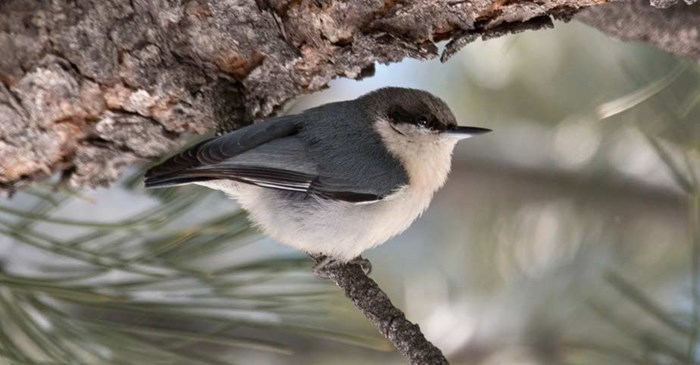To catch sight of the Pygmy Nuthatch, keep your ears open for the sounds of their peeping, squeaky “rubber ducky” calls overhead. Then, look up, way up, to the tops of ponderosa pines, and you may catch them hopping up and down the vertical surface of the tree. Read up on these fun facts about the Pygmy Nuthatch, and you’ll appreciate the traits unique to these tiny, slate-hued birds with buff-colored bellies.
Where does the Pygmy Nuthatch live?
The Pygmy Nuthatch is a year-round resident in the open ponderosa pine forests of the western U.S., with territories in pockets scattered through Colorado, Utah, New Mexico, Arizona, Idaho, Washington, and Oregon. While the Pygmy Nuthatch is not as common and widespread as other nuthatch species (such as the White-breasted Nuthatch), fossil records suggest it is a longtime resident of the western U.S. For example, in California, archaeologists uncovered a Pygmy Nuthatch fossil dating back at least 11,000 years.
The unique nesting habits of the Pygmy Nuthatch
As you may know, nesting season is an exhausting time for bird parents, as they work around the clock to search for insects, seeds, nuts, and other protein-packed quick bites to feed their rapidly growing nestlings. The Pygmy Nuthatch is a species that has a system that gives Mom and Dad a break. It’s one of the few songbirds where extended family members help the parents feed the chicks. In many cases, the nest helpers are grown offspring of the breeding pair. They even bring food to the mother while she’s incubating the eggs in their nest found in a tree cavity.
The Pygmy Nuthatch "layers up" for the winter
The Pygmy Nuthatch, like Blue Jays, Northern Cardinals, chickadees and more, doesn’t migrate for the winter. To maintain their body temperature, their layer of down feathers alone won't suffice. A steady source of fuel, in the form of calories, is their second defense against the cold. That’s why these birds spend the winter days searching for any seeds, nuts, and berries, still clinging to branches and stems (along with supplemental feedings at home feeders). The ultimate survival challenge comes at nightfall. Colder temperatures and sustained periods of darkness mean they need to give their bodies sufficient fuel before going to bed. According to the Cornell Lab of Ornithology, the Pygmy Nuthatch deploys three energy-saving tactics. The Vaux's Swift is the only other bird that takes this multi-faceted approach:
- They drop into a state of torpor, where they lower their body temperature by a few degrees.
- They take shelter in a nesting box or tree cavity.
- They roost together with many other birds, which means that they huddle close together to block the release of body heat. One biologist saw 150 Pygmy Nuthatches cram into one cavity nest. (No word on how large of a space it was, but that’s still an impressive number of birds in a confined area with a single exit!)
This winter, you can support the Pygmy Nuthatch by providing food and shelter. Hang a nesting box that lets them roost, and maintain a steady supply of protein-packed food. Lyric Chickadee Premium Sunflower & Nut Mix features a blend of sunflower seeds and nuts that’s sure to please and fuel a flock of Pygmy Nuthatches.
